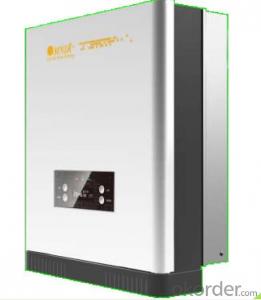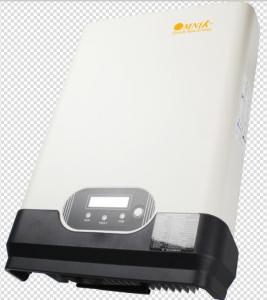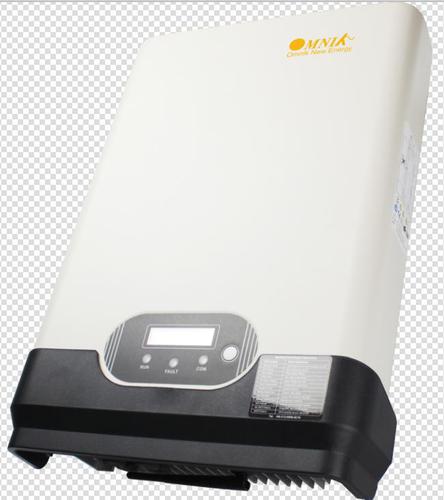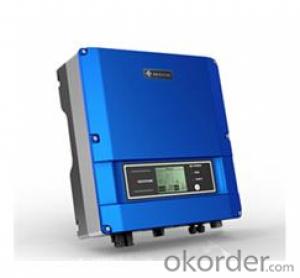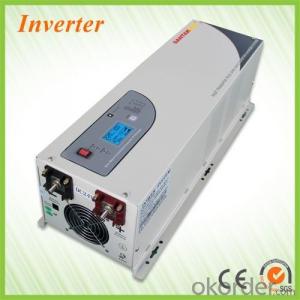on grid solar inverter Omniksol-5.0k-TL2
- Loading Port:
- Shanghai
- Payment Terms:
- TT OR LC
- Min Order Qty:
- -
- Supply Capability:
- 3000 pc/month
OKorder Service Pledge
OKorder Financial Service
You Might Also Like
Omnik new energy solar inverter
Omniksol-2.0k-TL Photon Efficiency up to 3kW
in the world------ Photon tested Jan. 2012.
Omniksol-3k-TL2
Futures
Transformerless design, high efficiency (Max.97.8%,Euro. 97.3%)
Multi -button touch interphase
build in GPRS,WIFI as optional
Smaller,lighter, 5KW,16kg
IP 65 design, suitable for indoor and outdoor installation
10 years warranty(10~25 years as option)
technical data:
Type | Omniksol-3.0k-TL | Omniksol-4.0k-TL | Omniksol-5.0k-TL |
Max. PV-Generator Power [W] | 3400 | 4600 | 5200 |
Max. DC voltage [V] | 590 | 590 | 590 |
MPPT DC voltage Range [V] | 120-500 | 120-500 | 120-500 |
Turn off DC voltage [V] | 90 | 90 | 90 |
Max. DC Current [A] | 12*2 | 16*2 | 18*2 |
Nominal DC Current [A] | 10*2 | 13*2 | 14*2 |
Number of DC Connection | 2 | 2 | 2 |
DC-Connection | MC4 | MC4 | MC4 |
Number of MPP trackers Turn on Power [W] | 2 | 2 | 2 |
Turn on power(W) | 10 | 10 | 10 |
- Q: Can a solar inverter be used with a solar-powered air purification system?
- Yes, a solar inverter can be used with a solar-powered air purification system. A solar inverter is responsible for converting the direct current (DC) produced by solar panels into usable alternating current (AC) for powering electrical devices. In the case of a solar-powered air purification system, the solar inverter would convert the DC power generated by the solar panels into AC power that can be used to run the air purification system. This allows for the system to operate efficiently using clean and renewable solar energy.
- Q: Can a solar inverter be used with solar-powered water heaters?
- No, a solar inverter cannot be used with solar-powered water heaters as they operate on different principles. Solar inverters are designed to convert the direct current (DC) generated by solar panels into alternating current (AC) for use in residential or commercial electrical systems. On the other hand, solar-powered water heaters use sunlight directly to heat water, without the need for converting DC to AC. Therefore, these two systems are not compatible with each other.
- Q: What is the maximum DC input current for a solar inverter?
- The maximum DC input current for a solar inverter can vary depending on the specific model and manufacturer. It typically ranges from a few amps to several hundred amps, depending on the size and capacity of the inverter.
- Q: Can a solar inverter be used for commercial applications?
- Yes, a solar inverter can definitely be used for commercial applications. In fact, solar inverters are commonly utilized in commercial settings to convert the direct current (DC) electricity generated by solar panels into usable alternating current (AC) electricity that can power various commercial appliances and equipment.
- Q: PV grid-connected inverter and independent inverter in the control of what is the difference
- PV grid-connected inverter in the grid before the inverter needs to determine the phase voltage phase frequency, the first phase-locked, in the grid and power generation.
- Q: How do you troubleshoot common issues with a solar inverter?
- To troubleshoot common issues with a solar inverter, start by checking the power source and ensuring it is connected properly. Next, inspect the wiring connections to ensure they are secure and not damaged. Additionally, check the fuse or circuit breaker to see if it has tripped or blown. If the inverter displays an error code, refer to the manufacturer's manual for troubleshooting steps. If none of these steps resolve the issue, it is advisable to contact a professional technician or the manufacturer for further assistance.
- Q: What is the role of a solar inverter in fault ride-through capability?
- The role of a solar inverter in fault ride-through capability is to help maintain the stability and reliability of the power grid during faults or disturbances. By detecting and responding to voltage and frequency variations caused by faults, the solar inverter can adjust its output and remain connected to the grid, ensuring continuous power supply. This capability is essential for grid stability and allows solar power systems to contribute to the overall reliability of the electrical network.
- Q: Can a solar inverter be used with a solar-powered cooling system?
- Yes, a solar inverter can be used with a solar-powered cooling system. A solar inverter is responsible for converting the direct current (DC) electricity generated by solar panels into alternating current (AC) electricity that can be used to power various appliances, including cooling systems. By integrating a solar inverter into a solar-powered cooling system, the system can effectively harness solar energy to operate and provide cooling without relying on external power sources.
- Q: Can a solar inverter be used with a hybrid solar system?
- Yes, a solar inverter can be used with a hybrid solar system. In fact, a solar inverter is an essential component of a hybrid solar system as it converts the DC power generated by the solar panels into AC power that can be used to power electrical devices or be fed into the grid. The inverter also allows for the seamless integration of other power sources, such as a battery storage system or a backup generator, in a hybrid solar system.
- Q: How does the size of a solar inverter affect its performance?
- The size of a solar inverter directly affects its performance. A larger inverter can handle more power and can convert a greater amount of DC electricity from solar panels into usable AC electricity for consumption. This allows for higher energy yields and improved efficiency. On the other hand, a smaller inverter may not be able to handle the full capacity of a solar panel system, resulting in power limitations and potential energy losses. Therefore, selecting the appropriate size of a solar inverter is crucial for optimizing system performance.
Send your message to us
on grid solar inverter Omniksol-5.0k-TL2
- Loading Port:
- Shanghai
- Payment Terms:
- TT OR LC
- Min Order Qty:
- -
- Supply Capability:
- 3000 pc/month
OKorder Service Pledge
OKorder Financial Service
Similar products
Hot products
Hot Searches
Related keywords
